Utlizing ‘AI’ Artificial Intelligence Software in the Hospitality Industry
Have you ever wanted more time and more help in your...

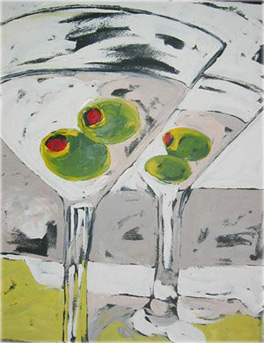 What To Expect From This Series
What To Expect From This Series
Over the next year or so, from time to time, I will continue this series on Mixology I am calling “The Accidental Mixologist” from the perspective of an everyday bartender, that I hope will open some eyes and changes some minds. My hope is that I am not the only bartender who enjoys flipping bottles as much he enjoys crafting cocktails and that at least a couple BottleSlingers out there would appreciate some insight to the wonderful world of mixing cocktails. My goal is to help demystify the idea of Mixology and give you the confidence to become simply stunning at mixing cocktails no matter where you work or what your background. I hope to serve as inspiration that you do not need to wear a fancy jacket, hold a world title, or work in some obscure hotel cocktail bar in order to become an accomplished cocktail craftsman. If nothing else, I hope it makes some of you a little more money behind the bar. Why not start with the Holy Grail of Cocktails? That’s right: the Martini.
The following introduction is taken directly from my forthcoming book on building beverage programs, which I have plans to self-publish sometime before I turn 90. Stay tuned. And stay alive. And stay classy.
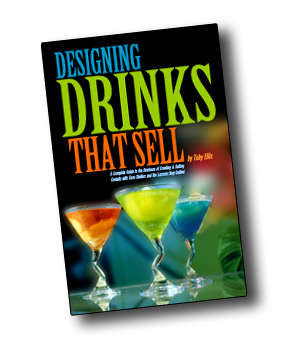 My Introduction to Mixology
My Introduction to Mixology
As an Upstate New York college-town bartender in 1989, I quickly learned the power of a well-designed specialty drink and a potent, tasty shooter. Trying to make money in a market saturated with bartenders overpouring and giving the house away, I turned to specializing in creative drinks to rise above the pack. Most of my early work was complete trial and error on dead shifts. Bored and curious, I would spend hours mixing together whatever ingredients were within reach and pawn them off on unsuspecting victims, er… guests, for as much as I could muster.
Another strong influence was that I simultaneously bartended in a popular college bar where shot boards where normal fare and also for the college catering department, the equivalent of banquet bartending where my most exciting mixer was a dusty bottle of Amaretto. So while at the bar I was accustomed to mixing up dozens of wild shooters for wilder college partiers, at the catering department I was handcuffed by a pale pantry of brown spirits and cheap Vodka to work from. Once or twice a year, I would be blessed with a mis-ordered case of sour mix but most days I had next to nothing to work with. Trying to come up with shots and cocktails at my second job proved highly frustrating. That frustration sparked a lot of creativity and a ton of nasty-tasting mistakes.
So while many bartenders who delve into mixology do so out of some lofty pursuit or upscale attempt at artistry, my roots in the art of drink design were born out of survival. I mean, just how creative can you get with your basic four white liquors, Vermouth, Bourbon, Scotch and a meager pantry of juices and sodas? At the catering department we rarely even had the luxury of pineapple juice, cream, or even basics like Triple Sec or Peach Schnapps. Luckily, grenadine and sweetened lime juice were always available as were fresh fruit and packets of sugar. The best way to describe my early phase of mixology would be “ghetto mixologist.” I improvised.
My progression into a world-champion mixologist came almost completely by accident and quite slowly, I admit. I have always had an innate love for being creative and trying to make people happy through drink, but other than a few minutes with Bobby G. at a trade show, I have never had any formal or classic Mixology training to speak of. I do consider my training at TGI Friday’s ten years ago to be quite intense and amazingly helpful in my development as a bartender, though I don’t know if I would call it Mixology training as much as technical bartender training. Tough call. Either way, I’ve never considered myself a Mixologist. I am just a blue-collar bartender who likes to make drinks. To this day, I have shied away from any of the titles many of my colleagues cling to. Hence you will never hear me refer to myself as a “Master Bartender” or “Mixologist” or “Bar Chef” or even “Flairtender.” Truth be told, I loath such titles. I have always been and will always be, nothing more and nothing less than…. a bartender. Even when I was President of the FBA, my business card read “Toby Ellis… Bartender.” Even now, as a bona fide nightlife consultant with ten years of contracts under my belt, I refer to my self as nothing more than a bartender, except when the media and business, force me to do otherwise. I am proud of the title bartender. Anything else is just window dressing, a sometimes necessary evil I have learned to accept.
Have you ever noticed how almost every book or article about the Martini begins like this: “What is it about the Martini?”
Generally, this is followed by pages and pages of lore and speculation of the most famous of all cocktails peppered with a few cute anecdotes about James Bond and The Rat Pack. My experience with the Martini is, like the nicotine in my life, purely secondhand. Don’t get me wrong: I love the idea of “Slipping into a Martini,” it’s just the actual drinking of the Martini I’ve never warmed up to. Something about buddying up to a glamorized double shot of vodka just doesn’t appeal to me. And that used to make my life as a bartender a little rocky. When I first started bartending, back when my buddy Edison was tinkering with the light bulb, I was intimidated by Martini drinkers. There was something so mysterious, so elusive about the cocktail and the people who drank them I didn’t think I’d ever unlock their dark secrets. Everybody had theories and rules and suggestions and even philosophies on what makes the perfect Martini. And none of it made a damn bit of sense to me. Luckily time was on my side. About five years behind the pine and I started to realize something invaluable:
Martini drinkers are a funny lot. Bunch of drunks, too.
So now after pouring a Martini or two here and there over a couple, two, three , er…. fifteen years (or so), I thought I’d share with you, what I’ve figured out, for certain, about the Mona Lisa of cocktails and as important, the people who order them. Are you ready?
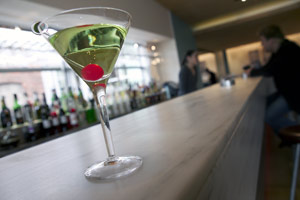 What a Martini Is and Is Not
What a Martini Is and Is Not
A Martini may or may not contain Vodka, Gin, and/or Vermouth. A classic Martini is always made with Gin, never Vodka. Except when it is made with Vodka, never Gin. A Martini is supposed to be clear; but is now acceptably served blue, green, pink, red, yellow, black, white, aqua, orange, or multicolored. Originally, it was a very trendy thing. Then it became classic. Then trendy again. Then it was forgotten about. Then trendy again. Then retro. And yet again, trendy. But it’s falling by the wayside now, again. Give it a few months, maybe a year or two, and it will be the rage again.
Shaking a Martini makes it taste either much, much better or ruins it all together. Stirring a Martini does nothing for it, or makes it much, much better. The proper garnish for a Martini is without a doubt, an olive. Or a lemon twist. Or nothing. And once upon a time, six to eight different bartenders, from four separate countries, over the course of 20 years, all are the historically proven inventor of the drink. And the true secret to making a great Martini is: a whole bunch of things that all seem to contradict each other, on the surface. As you can see, I’ve become quite an expert on the Martini over the past fifteen years.
Best I can figure it, the one (and perhaps only) thing Martini drinkers share is a love for the total experience of the Martini. It’s not a about one “right” way to make it, it’s more about the process of making it “right” for that one person. Just as a Grateful Dead show was not just a concert, so is a Martini not just a drink. To the outside observer, there is no difference between the two. But to those who know better, it is the subtleties that make all the difference. And so without too much more ado, I will share with you some observations I have made about Martinis that might actually serve you well. But first, some requisite preamble.
A Warning to Mixologists
I’ve always been someone who first reads, studies, and listens about a topic to learn what I can. Then I generally take this book and secondhand education and put it to the test myself. Bartending is no exception. This approach usually leads me to dismiss a good amount of what I read and heard as complete rubbish or at the very most, interesting coffee table conversation that has little to no practical value behind the bar. Such is most of what I have read and heard about Martinis. Most of the experts I’ve encountered ramble on and on with meaningless flowery descriptions, comparing the process of Martini making to that of painting the Sistine Chapel. It’s not a priceless masterpiece hanging in the Louvre; it’s a friggin’ double-shot of vodka in a pretty glass, damnit! Why must we make every new bartender tremble at the idea of making a Martini as though there is some magical chemical process only five master mixologist monks living in the peaks of the Himalayas have uncovered after decades of empirical research and divine meditation? Or that it is the most revered piece of artwork that only a few gifted prodigies dare attempt to perfect for Kings and Queens? Please. So to anybody out there who still maintains that making Martinis requires decades of experience and years of training, I say unto you in a loud, obnoxious cough: Bullshit.
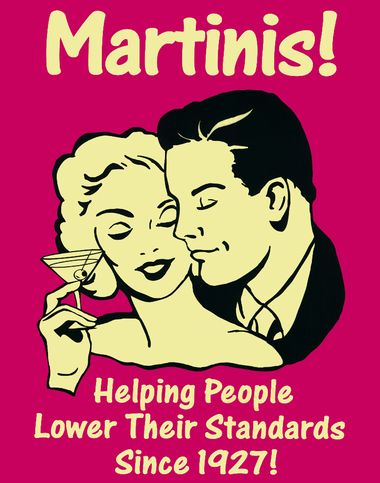 Martinis are a cakewalk, once you understand a few simple truths about them, which I am (sooner or later) going to share with you. The cat is out of the bag, the shell game is over. Sorry to all the “bar chef” wannabes who have been trying to use smoke and mirrors to make the rest of the blue-collar bartenders think we have no idea what we’re doing when it comes to the classics; but I’m calling your bluff. Martinis are nothing more than a big stinking shot of booze, dressed up to look elegant.
Martinis are a cakewalk, once you understand a few simple truths about them, which I am (sooner or later) going to share with you. The cat is out of the bag, the shell game is over. Sorry to all the “bar chef” wannabes who have been trying to use smoke and mirrors to make the rest of the blue-collar bartenders think we have no idea what we’re doing when it comes to the classics; but I’m calling your bluff. Martinis are nothing more than a big stinking shot of booze, dressed up to look elegant.
The Martini is the most pretentious cocktail man has created.
It’s nothing more than a way for hardened alcoholics to get absolutely hammered in public, in an civilized manner. It’s a classy way to get schnockered. Period. End of story. Save your Hemingway and Sinatra romanticized fantasies about cocktail drinkers… both were big drunks. Dean Martin? Drunk. JFK? Drunk. Winston Churchill? Drunk. Anybody you can think of, who helped romanticize the Martini or any other classic… is a drunk. They knew it, I know it, now you know it too. Call a spade a spade and let’s move on, shall we?
 The Genesis Of the Martini
The Genesis Of the Martini
Think I’m simplifying things? The fact is the most of our “classic” cocktails including the Martini were either created or came into vogue during and/or directly after Prohibition in the United States. Two forces were at work here. First, since the production and sale of spirits became illegal, most people got their booze in the form of the aptly-named “Bathtub Gin” which had a notorious burn to it thanks to the quick and crude method by which it was made. So anything that could mask that harsh gasoline flavor was added to it and hence we saw recipes springing up everywhere that included honey, sugar, fruit, egg whites, bitters, vermouth, etc.
 The other catalyst for the popularity of cocktails like the Martini was the dynamic of the Speakeasy. Imagine being out at your favorite bar. Now imagine that this is a totally illegal activity which could easily land your ass in jail. No imagine it’s the middle of the worst depression America has ever seen, so you’re pretty broke. You and everybody in the joint knows and fears, that at any moment the police are going to come busting through the front door and throw you all into the paddy wagon. Naturally, you want to make sure you get a guaranteed buzz from the week’s wages you just plunked down on one drink. You need something that packs a wallop and that you can ingest in an instant, if you have to make a run for the back door. Who had time to try and guzzle a glass full of juice or carbonated soda just to get to their booze? Hence, the cocktail became the drink of choice in America.
The other catalyst for the popularity of cocktails like the Martini was the dynamic of the Speakeasy. Imagine being out at your favorite bar. Now imagine that this is a totally illegal activity which could easily land your ass in jail. No imagine it’s the middle of the worst depression America has ever seen, so you’re pretty broke. You and everybody in the joint knows and fears, that at any moment the police are going to come busting through the front door and throw you all into the paddy wagon. Naturally, you want to make sure you get a guaranteed buzz from the week’s wages you just plunked down on one drink. You need something that packs a wallop and that you can ingest in an instant, if you have to make a run for the back door. Who had time to try and guzzle a glass full of juice or carbonated soda just to get to their booze? Hence, the cocktail became the drink of choice in America.
 The end result, once Prohibition was lifted, is that we now had a culture and a set of recipes that made getting wasted… stylish. Sophisticated. Glamorous. And the Martini was the Battle Cruiser of cocktails that led this march. Only a lowlife bum would guzzle down a double-shot of vodka back in the 1920s, 30s, 40s and 50s. But a lady or the most dapper of gentlemen could order a Martini with full confidence it was not only socially acceptable, but even elegant. Yes, the Martini gave the hardcore drunk a covert way to throw back a big stinking shot of gin and look like a debutante. Brilliant, wasn’t it?
The end result, once Prohibition was lifted, is that we now had a culture and a set of recipes that made getting wasted… stylish. Sophisticated. Glamorous. And the Martini was the Battle Cruiser of cocktails that led this march. Only a lowlife bum would guzzle down a double-shot of vodka back in the 1920s, 30s, 40s and 50s. But a lady or the most dapper of gentlemen could order a Martini with full confidence it was not only socially acceptable, but even elegant. Yes, the Martini gave the hardcore drunk a covert way to throw back a big stinking shot of gin and look like a debutante. Brilliant, wasn’t it?
If you take off your fancy red sport coat for a second, and really think about it… what is the real difference between a cocktail and a shooter? Best I can tell, it’s about 4 inches of stem. Not much else. In fact, I started serving lemon drops and other shots in Martini Glasses (and still do now and again) after I watched a bartender in DC do this all night. Nice way to dress up (aka add perceived value) to a shooter. And that got me thinking too… how many people really sit and “sip” a cocktail? How many people who truly appreciate the nuances of a finely-crafted cocktail want one that has as much booze in it, as flavoring agent? Not many. I do, but I’m sort of a freak. The cold, dry, bitter truth that nobody but me apparently wants to tell you, is that most people who drink Martinis want to get drunk. C’mon… the three Martini lunch?! I rest my damn case.
 Types of Martini Drinkers
Types of Martini Drinkers
Maybe not every single Martini Lover is a hardened alki, but let’s be honest: go to any bar in the world at random and I’ll bet you a week’s wage or tips, that 18 out of 20 people who order a Martini aren’t sitting quietly in the corner musing Salinger’s Catcher in the Rye, page for page, slowly sipping on their glass of Gin or Vodka. The other two are faking it. Shit, most people that order Martinis are digging through a pack of smokes and eyeballing the room for potential bedmates while their raspy voices belt out through a cloud of smoke: “Martini, extra dry, two olives” in a way that is frighteningly reminiscent of Marge Simpson‘s older twin sisters, Patty and Selma Bouvier. Let’s stop kidding ourselves about esoteric verities of this over appreciated classic and the people who drink them. In fact, let’s do one better: let’s cut through the bullshit and nail down the simple truths about the subject. First, the people who order Martinis.
 1. The Curious Tourist
1. The Curious Tourist
Like somebody who just wants to know what all the fuss is about this thing called “Sushi,” there are a decnet number of people who decide to order a Martini, thinking it will be some world-changing experience in their lives. They will muster up some fake bravado and say to you “Martini” sometimes with the uber-cheesy follow-up of “shaken, not stirred.” Now as you attempt to prevent your eyes from rolling into the back of your head, you come back with a quasi-polite “How do like them?” And that’s when you know you’ve got a weekend warrior on your hands. It’s that blank stare, that sheepish grin that tells it all. They don’t have a fucking clue. They don’t even know what a Martini is let alone how to order one. If you’re in a good mood or still blissfully green enough to believe in the rookie-mantra of “giving everyone great service every time” you’ll walk them through it, and probably end up pouring a Cosmo, Lemon Drop, French Martini or maybe, just maybe a Dirty Martini. G-d bless your little heart. These people are easy to deal with once you establish that simple truth that they have no idea what they are doing and need your help so as to not look completely foolish.
 2. The Wannabe Hipster
2. The Wannabe Hipster
Then there’s these clowns. Very similar to the Curious Tourist with one annoying, distinguishing difference. They refuse to give up the charade. They insist on keeping up pretense that they actually like and regularly drink Martinis even though you know they don’t know an olive from a cherry. There are often given way by the youthful appearances and their preoccupation with trendy clothing and accessories including the need to try and standout by smoking imported cigarettes or loudly talking about trendy topics they picked up on Yahoo! or MySpace that afternoon. These are usually the creatures that spend as much time rubbernecking to see who’s watching them, as they do actually making eye contact with the person they are supposedly in conversation with. You can usually deal with the Wannabe by quickly shaking them a stiff, extra-dry Vodka Martini Up with a couple olives and giving them that same look D’Mitch Davis, the bartender in the movie Weird Science gives the Robert Downey Jr (Ian) and Robert Rusler (Max). It’s that “You’re not fooling anybody and you and I both know it” look. Or as D’Mitch put it: “That’s what I thought you was gonna say.” If you can crack through their facade, you’ll probably find it worth your time to get them started on Dirty Martinis, the White Zinfandel of Martinis. It’s the beginner’s Martini that still makes them feel “cool” and “older” which is what they are after anyway. Giving people what they want goes a lot further than the drink. Remember that. You’ll make a lot money off that idea if you apply it to more than just the drinks you put across the bar.
 3. The Savvy Socialite
3. The Savvy Socialite
This breed is more common at catered functions and “power bars” of big cities like Washington DC, LA, London and New York where people are drinking as a way to lubricate business deals. And this drinker is probably going to order three or four Martinis in an hour or two, but if you pay close attention, you will notice they don’t actually drink down more than a half of one in total. And thus, they generally don’t pay a lot of attention to you making their Martini or how it ends up looking or tasting. I bang these Martinis out as quick as possible. Understand, that doesn’t mean cutting corners, it simply means trimming out the extra “love” and care, the show of making a Martini, that I will get into in a bit. These types appreciate a quick drink that is not overfilled so they can mingle without spilling. They’re easy to deal with.
 4. The Hardened Lush
4. The Hardened Lush
You probably know how to spot this species by now. They have that “Hardened Criminal” look about them when they come up to the bar like they know there way around the driest of Martinis and prefer to be left alone with their drink and a pack of Marlboro Reds. Sometimes they’re given away by the broken blood vessels around their noses, other times is the deadpan delivery of their order. Either way, this is the Martini drinker you pay attention to, or should I say watch out for. I’ve never understood what makes someone who really drinks Martinis think they are somehow “above” everybody else (including the bartender), but often they do. As though being a stinking drunk is somehow an honor, a title to be proud of. And that’s probably the hairiest part of dealing with this type. Suffering through the verbal diarrhea that only stops pumping out of their mouths long enough for olives and Vodka to sneak past. For these people, there does not seem to be joy in appreciating the Martini, but rather a need to marinate within in. Not my favorite bar guest, to be sure. Be sure to establish dominance with them early on, or they might try to walk all over you with their need to be an armchair bartender.
 4. The Real McCoy
4. The Real McCoy
This is the Martini Drinker you wait your whole shift for. The person who isn’t drinking a Martini as a social accessory to impress anybody. They aren’t coming from their weekly 12-step meeting with a mission to go blind, nor are they a clueless tourist out to “try something new.” This is the true Martini drinker who actually appreciates a well made cocktail. These are the people who will just slide you a quiet smile and a nod (and probably a fat tip) when they notice you care and you excel at making their Martini. They are very particular to the point of being fussy. But you will know them an instant by the way they call their drink. “Citadel Martini, very dry, very cold, up, two olives, stirred. Thank you.” Now this is the creature that will make reading through another one of my tirades worth the trouble. And the type of person I will go out of my way to make one of my regulars. Quite simply put, they will appreciate your art.
Knowing which type of animal you are dealing with can greatly improve your odds of gaining a reputation for making “Great Martinis.” It can also help you avoid wasting too much time on people who simply cannot and will not appreciate true craftsmanship. But just as important as understanding the drinker, you should understand the drink. Yes, Martinis have a mind of their own in a way, and you need to crawl inside of it for a spell, in order to become a master.
The Interview
The interview works with a lot of cocktails and drinkers, but is more important, I think , for the Martini types. I worked for TGI Friday’s for seven years and they turned this into a methodical process with question after question. I found that to be a bit cumbersome and unnecessary (though intelligent and visionary) and have since reduced the entire Martini Interview to one simple question:
How Do You Take Them?
Don’t ask me why I like the word “take” but I do. Ask this question and you’ll either get a perfectly called order or at the least, you’ll know you need to spoon-feed this person, step by step.
 The Martini Mentality
The Martini Mentality
Much of Martini making, in fact most of it, is show. Because once again, a Martini, no matter what any book tells you, is for 99% of the drinking population, a double-shot of chilled vodka (or gin) in a fancy glass. So the real secret to Martinis, then, is the show of making them. And that’s what most Martini drinkers want. It’s a totally different kind of flair. A subtle, gentle style of flair. And it begins with the glass and doesn’t stop until the first sip. All I can say is that cocktail aficionados seem to appreciate what I can only describe to you as a dance in slow motion, when making their Martinis almost as much as they seem to cringe at the sight of a bartender flairing their “little baby” instead of laboring over it. So while I may let the bottles fly for a Long Island, when it’s time to pour a Martini: my style usually down shifts a gear or two. The club may be playing Young Jeezy, Eminem, Sean Paul, Kid Rock or Lil’ Kim but in my head when I’m crafting a Martini, I’m hearing Sade, Mel Torme, Al Jarreau, Frank Sinatra, or Marvin Gaye. It’s a different kind of flair, one that focuses more on flowing movements and subtle gestures, rather than big, crazy flips or rock and roll taps, bumps and captures. Most of the time, nothing leaves my hands. Static flair I sometimes call it. Little, simple stuff that most people don’t notice. Stealth flair I’ve been known to say.
So do be careful when flairing a Martini, if you have any aspirations of gaining respect for your cocktail-making abilities. As a rule, Martini drinkers are not big fans of flairing and I have never had a problem with this. In fact, I total get it. Ordering a Martini to true Martini-Lovers is like acquiring a diamond. It’s something priceless and delicate, not something to be sloshed, spun, and played with. It is something to be carefully crafted and delicately delivered. Long pours are a safe bet and that’s about it. The entire process should have a quiet, understated, but stylish flow. Isn’t that what a Martini’s mystique is all about? So sell it with your body language instead of your bottles. Just a suggestion. Do as you please, and learn for yourself what works.
 Clean Glass
Clean Glass
You’d think this would go without saying. But how many times have you watched another bartender pour a drink into a spotted or even lipstick-stained glass? Sad but true. One of the best time-killers when it is slow is glass polishing. Also, make a habit of holding glassware up against the light as you pick it out. In this way, you start selling the craftsmanship of the cocktail (and you, the cocktail-maker), before you lift a bottle. Same goes for your shakers and mixing glasses. Especially when making a straight Martini, make sure you are usually well-rinsed mixing tins and glasses. I have an odd habit of smelling my tins before making a Martini which a friend once questioned. I returned with “Try it sometime. It will blow your mind how many times a clean looking tin has the odors of the last drink you made, trapped inside.” And nothing will ruin a Martini faster than cross-contamination from the last cocktail in your tins. Do what you have to to start with clean glasses, tins, and tools. Even if that means taking the time to wash them all right in front of the guest, while they wait. If they are a true Martini drinker, they will appreciate it just as a true Guinness drinker appreciates a slow pull.

Cold, Cold, Cold
I used to keep a half dozen cocktail glasses filled with ice on my bar top, always making sure they didn’t melt down into water which meant replacing them when needed with fresh ice. That was a big part of telling people “This kid can make cocktails, fear not.” I always shake the excess liquid of out the glass as well. If you have a glass chiller or space in your reach-ins to freeze or frost your glassware, even better. Same for your premium vodkas. See, even though the reality is that drinks that are too cold mask flavor (and numb taste buds) the perception (which is always more important, sadly) is that colder is better. So you prechill your glass, your mixing tin. And you stir or shake (probably shake) your Martini until the tin starts to frost up on the outside.
 Stirring vs. Shaking
Stirring vs. Shaking
First things first: you can bruise a pear, you can bruise an arm, you can bruise an ego, but you cannot bruise Gin. Think about it. If Gin (or any other spirit) could actually be damaged or spoiled from shaking in a mixing tin then please somebody explain to me how it remains unaffected by the sloshing and splashing that occurs during production and bottling, and how it survives the less than delicate ordeal of shipping and distribution? The idea of Gin bruising is just another urban legend, an old wives’ tale, if you will. The only tangible, significant difference between stirring and shaking besides perception and personal preference, is color. Stir a Martini and it will pour clear. Shake a Martini and it will pour cloudy. Same with just about any cocktail that is translucent, like a Cosmopolitan. And ok, it will take a little longer to reach the same degree of mixing and chilling when stirring as opposed to shaking. Shaking is certainly faster. But which technique is “correct?”
Here’s your answer: THE RIGHT WAY TO POUR A COCKTAIL
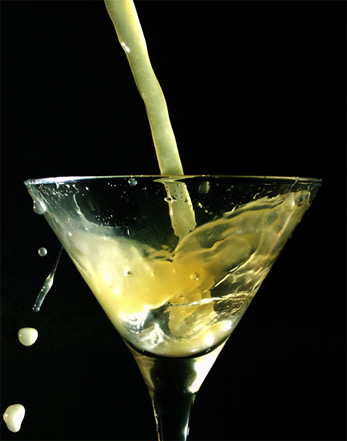 The Perfect Pour
The Perfect Pour
Really, I’ve always found the most difficult part about making Martinis to be the pour. Most of the bars I’ve worked in at least, didn’t give a half minute’s thought to portioning and just picked glassware based on a manager or owner’s personal tastes or thriftiness. This usually means a cocktail glass that is too small or too large. You’re screwed in either case. Too small and your Comsos and “Fruit”-tinis look tiny or have to be made out of proportion. Too large and your Martinis look underpoured. How many times have you been in that awkward position with your 10oz Martini Glass and a call for a Cosmo and an Extra Dry Martini? Now how on earth are you going to pour a Cosmo and a straight Vodka Martini in the same sized glass without making one a larger pour than the other? Please don’t tell me you’re pouring a 6oz Vodka Martini. So what’s a bartender to do? Earn your salary. Here’s a few tricks to help you out. But you’re going to have to give up your holier-than-thou notions of perfect bartending and grasp on to a more pragmatic, realistic view of pouring drinks.
Start By Getting Real
In a society where pretense and money rule the day and taste is all but a forgotten ideal, you want your cocktails to look like a million bucks as much, if not more, than you want to sweat about making them taste like a million bucks. Did I really just say that? You bet your ass. Hey, let’s stop writing articles and making speeches that cater to the tastes of five sommeliers and a couple wine critics who hang out at the one Martini bar on the Upper East Side and write reviews for GQ and The Post. Who gives a fuck what they think? (Not me.) I’m worried about the other 4 billion people on this ball of granite who don’t have the faintest clue about the subtle flavor nuances that can make or break a Martini, Cosmo, Pink Lady, or SideCar. I write about the real world and I hope you both realize and appreciate the value in that.
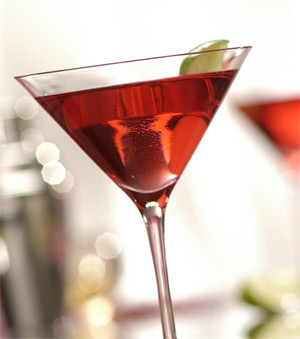 Tricks of the Trade
Tricks of the Trade
Yes, we all want to claim we tirelessly work towards perfecting our craft, but c’mon… fess up. (I am). The truth is most of us want to get through the shift striking a balance between artistry/perfection and making money without getting a lot of whining or complaining. And nothing will get people whining faster, than an under-filled cocktail glass. So do what I do, suck it up, and just humor them. Hit that Lemon Drop with an extra bump of Sour. Pad that Cosmo with an additional ounce of Cranberry. And yes, I’ll say it: cut down on your ice so when you shake that Dry Martini, the ice melt yields and extra ounce or more of Martini. Save your high and mighty ideals for the day you actually work in a world-renowned cocktail lounge or for those precious moments when you’re in competition. Here’s some other tricks that will help you handle mismatched glassware.
1. Lobby for Extra Jumbo Olives. Pick at least three and put it into the glass before you pour. Amazing how much volume three olives can take up in a glass, isn’t it?
2. Overfill your cocktails. Pour them to the rim (no collar) and pour the excess in a side rocks glass. Tell people “better take a sip before you pick it up.” I didn’t make this one up, a crafty bartender from back East did and he’s been voted most popular bartender in his city more than once. Smart move, though purists are probably cringing in their seats. See, he is delivering “extra” with every cocktail he pours and at the same time, making it easier to pour perfect cocktails… because every one is an overpour. I would not recommend this in the service well or at a club where everybody has to walk through a crowd holding their cocktail but this is a great trick, if you can sell it to people, for bars where most guests are seated right at the bar.
3. Overshake. Personally, I think a cloudy pink Cosmo looks a lot better than a clearish red one. Same for Martinis. That’s just me. But besides making your creations colder, which people perceive as better, overshaking will usually add ice melt to your cocktails and also volume. Extra shaking sells you as a “professional” bartender as well since many bartenders do half-assed shaking, if at all. As you get better, you will be able to judge how much ice to put in your shaker and how much to shake your cocktails, to create the perfect yield.
4. Charm and Disarm. So your boss is watching and has a strict rule about pouring no more than 2 ounces in your Martinis but the moron bought 9 ounce cocktail glasses. You can try to apologize and explain it to guests, but chances are no matter what you say, they’re going to see a half empty glass and feel cheated. Plus, if you try to explain, you’re just drawing attention to the problem. Do the opposite. Build rapport. Charm them. Disarm them. Distract them. Don’t tell me you’ve never poured a drink into a spotted glass and tried to distract the guest long enough for them not to notice and walk away, seemingly happy. You’ve done it. Admit it. Same idea. Make eye contact, engage them in conversation as you pour, and keep it going while you finish out the transaction. Great time to introduce yourself an shake hands. Anything to get them to hopefully not notice the paltry pour your just charged them $9 for.
Disclaimer: Look, I know some of this sounds horrible, but again: I work in the real world behind an actual working bar. I’m not some retired bartender from 10 years ago sitting in a publisher’s office playing bartender, trying to win a Pulitzer here. I’m trying to help you deal with real world obstacles behind real bars with tricks, techniques, and ideas that I have seen and made work time and time again. If you want righteousness and nobility from a bartender/columnist, there’s a truckload of them selling that manure. Have at it, lol. I’m telling it to you as straight as I know how. Would you expect any less by now?
The Devil is in The Details
There have been articles, demonstrations, speaking engagements, online debates, even books that detail all the unbelievable lengths certain bartenders have gone to in order to make the “perfect” Martini. Some have explored the chemistry of Martini Making noting the effect of various temperatures of ice, liquids and such. Others have attempted to perfect methods of seasoning a Martini with microscopic amounts of vermouth through the use of misters, rinses, etc. And still others have gone through the pain of making their own ice-cubes from distilled Artesian water so that no ordinary tap water, not even in solid form, ever touches their blessed creations.
 Maybe to you all of this seems pretty damn silly. I mean, seriously… how many bartenders work somewhere that warrants such extreme measures? Even for those who work in “Martini” Bars, there is usually a less-than-serious attitude about the drink. For every Milk & Honey and Savoy, there are 10,000 corner bars, restaurants, lounges, and airport bars where nobody, and I mean nobody, could give a rats ass if your ice cubes hail from Fiji or from the Faucet. So who cares about all this fuss over such trivial details? I do. And so should you. Because my three-bottle-cascading comrades, this is the real secret to making Martinis and most other cocktails. And too many bartenders glaze over this lesson. In fact, I get asked quite frequently what my “secrets” are to making drinks that win awards both in competition and in newspaper readers’ polls and such. And to that I can only say this:
Maybe to you all of this seems pretty damn silly. I mean, seriously… how many bartenders work somewhere that warrants such extreme measures? Even for those who work in “Martini” Bars, there is usually a less-than-serious attitude about the drink. For every Milk & Honey and Savoy, there are 10,000 corner bars, restaurants, lounges, and airport bars where nobody, and I mean nobody, could give a rats ass if your ice cubes hail from Fiji or from the Faucet. So who cares about all this fuss over such trivial details? I do. And so should you. Because my three-bottle-cascading comrades, this is the real secret to making Martinis and most other cocktails. And too many bartenders glaze over this lesson. In fact, I get asked quite frequently what my “secrets” are to making drinks that win awards both in competition and in newspaper readers’ polls and such. And to that I can only say this:
The devil is in the details
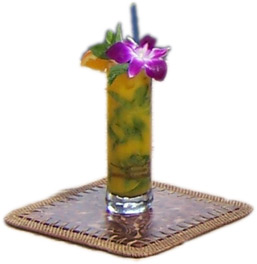 Put another way, you know all that “silly” little stuff people like me tried to teach you in that class or during that seminar that you thought didn’t matter? It does. There is no “one” thing that so-called master mixologists do that you don’t that puts their creations on top. It’s one hundred tiny things they do, every single day, for every drink, that sets them apart. Tiny details. And I’m the first one to agree that some of the lengths bartenders go to to make certain cocktails are beyond extreme and have no place in the real world of bartending. I am also the first to admit that the amount of passion you pour into one drink is totally dependent on the situation, the guest, where you work, how busy it is. That’s life. So no, you will not get the same Tangerine Mojito from me at work on a Saturday night at 2am as you will during a private event my company is catering. You will,however, always get the best possible cocktail I can make considering the venue and the situation. But it is the passion and the craftsmanship behind all of our advice that you should take a hint from. And no cocktail needs more passion and craftsmanship focused on it in many cases, than the Martini. Why? Because without detail, without show, it really is just a double shot of chilled vodka. So you are hopefully starting to see, the Martini needs all that extra care and love, just to exist.
Put another way, you know all that “silly” little stuff people like me tried to teach you in that class or during that seminar that you thought didn’t matter? It does. There is no “one” thing that so-called master mixologists do that you don’t that puts their creations on top. It’s one hundred tiny things they do, every single day, for every drink, that sets them apart. Tiny details. And I’m the first one to agree that some of the lengths bartenders go to to make certain cocktails are beyond extreme and have no place in the real world of bartending. I am also the first to admit that the amount of passion you pour into one drink is totally dependent on the situation, the guest, where you work, how busy it is. That’s life. So no, you will not get the same Tangerine Mojito from me at work on a Saturday night at 2am as you will during a private event my company is catering. You will,however, always get the best possible cocktail I can make considering the venue and the situation. But it is the passion and the craftsmanship behind all of our advice that you should take a hint from. And no cocktail needs more passion and craftsmanship focused on it in many cases, than the Martini. Why? Because without detail, without show, it really is just a double shot of chilled vodka. So you are hopefully starting to see, the Martini needs all that extra care and love, just to exist.
Thirteen Martini-Making Tricks that will Make you a Master
1. Polish their glass carefully right in front of them. Accept nothing less than sparkling.
2. Pre-chill the glass, the ingredients, the tools
3. Set the chilling glass (with bevnap) in front of the Guest (build the anticipation)
4. Become a student of ice-melt. Know how much ice you need to add just a little dilution, and how much you need to prevent any melt. Both methods come in handy.
5. Take your time. Slow down when you make a Martini. Show it some “love.”
6. Use long-pours. Really, really long long-pours. With simple, smooth, subtle cuts.
7. Try a rinse also known as an “In and Out” Martini. Simply pour a small amount of Vermouth (or other appropriate flavoring agent) into your mixing glass and ice, then strain and dump it all out, so that the ice cubes are only “seasoned” with this item. People will cringe and cry as you pour the Vermouth, but relax and smile with fascination and respect as you dump it back out. Try it.
8. Don’t use a cheater tin or plastic cup to shake. Use a mixing glass. Go buy one.
9. Sell the sound of a Martini. Hand Shake it with rhythm up over your shoulder.
10. Flair Pour the cocktail. I didn’t say flip it. I said flair it. Get low into the glass then pull up and long-pour, then go back low and swirl the remaining drops around. Experiment, but make a show of the pour. Don’t just dump it into the glass.
11. Jazzy Hands, baby. When you garnish, finish with some subtle punctuation with your hands is if to say “Viola!” I use motions almost like a magician. They are small, subtle and soft, but powerful. You are selling the perfection of your creations. Do not underestimate the power of this technique.
12. Make eye contact, smile and nod. It’s called “kissing the sale.” Tell the guest “Oh yea, you’re going to enjoy this” without saying one word. Confidence: Learn it.
13. After they taste, sincerely and without ego, ask it it’s how they like them. Insist they be honest with you and always offer to remake at your expense, not theirs. Winning over a Martini drinker as a regular is a crowning achievement, I think, as a bartender. It is a sign that you are on your way to mastering the craft. Repeat orders and repeat visits will tell you if you’ve succeeded, and nothing else.
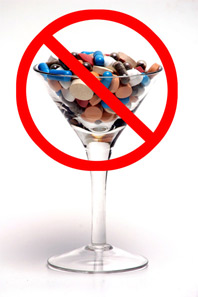 It’s All About The Love
It’s All About The Love
You know, the hardest part about teaching younger bartenders how to make Martinis and other classics isn’t the recipes; it’s the mentality. I worry that maybe, just maybe, somebody reads the column and thinks Toby Ellis is saying that Martinis are just shots of Vodka and that I am suggesting just banging them out like Jager-Bombs. Not even close. But understanding the true essence of a cocktail begins with breaking it down. What is it, really? What is it’s flavor profile? Who drinks it? Why? When? These are the things that matter. Not the simple recipe. And not what you read in some book called “Bartending For Dumb Asses.” Once you make that glorious discovery that cocktails are more akin to fitting people with expertly-tailored suits than they are to measuring out exacting chemical formulas for over-the-counter medicines, your prowess as a bartender will Skyy-rocket.
I was thinking back to when this all clicked for me as a bartender. I still remember when I had that epiphany. It was only seven years ago. (Yes, it took my slow ass eight years to figure this out. Hey, I’ve always maintained that I’m a slow learner. I’ve been flairing for fifteen years and I still can’t seem to figure most of it out, lol.) So learn from my mistakes and my discoveries and hopefully you’ll be a much better bartender than I, in far less time. If you haven’t yet had this clarity of mind yet, or even if you have, I think you might appreciate a piece I wrote for a local newspaper when I had my own personal little cocktail revelation. To this day, it’s one of my favorite pieces and I thought I would share it with you today in the hopes it will demystify the art of the cocktail for you at last. If you read nothing else in this month’s Cut Off, read this article.
 My name is Toby. I am a bartender. I spill, I drop, I break, I forget, I get frustrated, I cut people off, I short-pour rude, cheap people and I overpour good tippers, friends, and hot women. I fall into the weeds and I pull other people out of them. I cut up my fingers on a regular basis and scream profanities when lime juice gets into them, and oh yea… I’m half-deaf. Yes, I am indeed proud to be just another imperfect, hardworking, blue-collar bartender who earns a living slinging drinks, flipping bottles, and pouring Martinis. Not a bad way to pay the bills and see the world. Thanks for stopping by. And stay classy, San Diego. But most of all, thanks for stopping by. (Stay classy.)
My name is Toby. I am a bartender. I spill, I drop, I break, I forget, I get frustrated, I cut people off, I short-pour rude, cheap people and I overpour good tippers, friends, and hot women. I fall into the weeds and I pull other people out of them. I cut up my fingers on a regular basis and scream profanities when lime juice gets into them, and oh yea… I’m half-deaf. Yes, I am indeed proud to be just another imperfect, hardworking, blue-collar bartender who earns a living slinging drinks, flipping bottles, and pouring Martinis. Not a bad way to pay the bills and see the world. Thanks for stopping by. And stay classy, San Diego. But most of all, thanks for stopping by. (Stay classy.)
Have you ever wanted more time and more help in your...
MANGO MAGIC: Marco Estrada, Brownsville, TX 1 ½ oz Aviation Gin ¾...
ALOE WOK: Olya Sabanina, Saint Petersburg, Russia 1 1/3 oz Aviation Gin...
We have all strived to become better at our craft, or else,...
About the author, Elton Marvin Jr. has worked in the food and...
From starting out picking up a Flairco bottle after watching the movie...
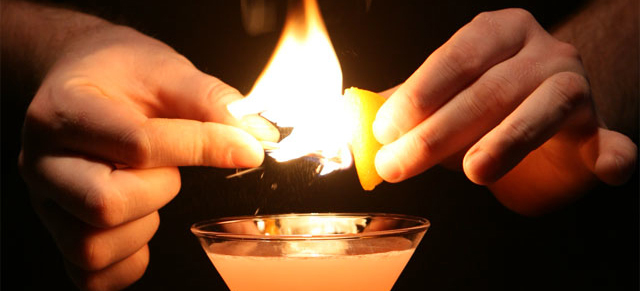
Your cart is empty.
Click “Play” on the video above.
Click “Play” on the video above.
Click “Play” on the video above.

